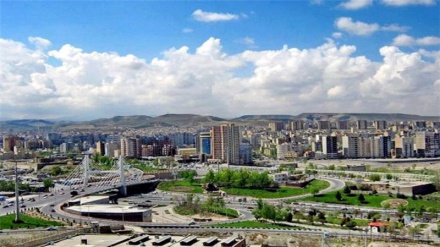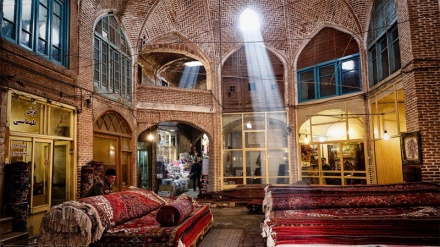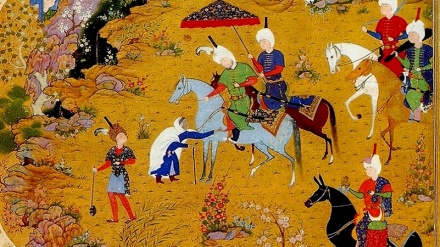Tabriz, 2018 (21)
Welcome to this week's episode of the series "Tabriz, 2018". Throughout the course of history, there are individuals, whose names are ever-lasting. There are courageous men, who defend and safeguard their country and nation, eternalizing their names and their country.
Tabriz has accommodated a number of courageous men, who have been sources of honor for their country. Today, we become familiar with some of them.
The history of the Constitutional Revolution is blended with the lives of two prominent Iranian figures, whose struggle against despotism turned the city of Tabriz into the symbol of national resistance and steadfastness. The names of Sattar Khan and Baqer Khan are familiar to those, who are well-versed on the history of Constitutional Revolution.
Sattar Khan is one of the Azari-speaking leading figures of Iran's Constitutional Revolution, who was born in the region of Arasbaran, in the vicinity of city of Tabriz in 1866 AD.
As of a young age, he defended the oppressed and stood up against the then regime. Hence, after one of his major confrontations with the then regime's agents, he was pursued, thereby leaving the city. He was well-known for his righteousness and trustworthiness in Tabriz. Therefore, a number of owners delegated the responsibility of protecting and safeguarding their belongings to Sattar Khan. He never attended school and was illiterate. However, his high intelligence, which was blended with courageousness and honed skills in the techniques of combat, religious beliefs, and patriotism, turned him into one of the leading figures of Constitutional Revolution.
Upon the start of the revolution against the then Qajarid King, Mohammad Ali Shah, in Tehran, and its spread to other cities, the Qajarid King suppressed the Constitutionalists. Freedom seekers of Azarbaijan region, under the command of Sattar Khan and Baqer Khan, supported the Constitutionalists in Tehran, standing firmly against the 40,000-strong army dispatched by Mohammad Ali Shah, and preventing the domination of the city by the suppressive forces.
Months into the siege of Tabriz; the Russian troops, based on an agreement with the British state, and Mohammad Ali Shah, crossed the border into Iran, and advanced toward Tabriz. As a result, the siege of Tabriz ended, and the Qajarid King's troopers left the environs of the city of Tabriz.
Sattar Khan and other Constitutionalists of Tabriz, who resented the invasion and incursion of Russian forces, send a telegraph to Mohammad Ali Shah, under the pretext of Russian invasion. Upon the receipt of telegraph, Mohammad Ali Shah instructed his troops to lift the siege of Tabriz. However, Russian forces continued to advance toward this city, and ultimately entered Tabriz. Based on the existing sources, the then Russian ambassador, who intended to hoist the Russian flag over Sattar Khan's house, was faced with the fierce opposition of this leading figure of the Constitutional Revolution, who prevented the Russian official from doing so.
Sattar Khan, who was set aside from the Constitutional government, lived another four years after this incident. He maintained communications with the central government in order to repel foreign forces, and announced his preparedness to fight against occupation of Azarbaijan, which fell on deaf ears. Finally, he passed away in Tehran in November 1914, and was laid to rest in the Holy Shrine of Hazrat Abdul-Azim (AS).
Baqer Khan was another leading Constitutionalist, who was born in Tabriz, in 1861 AD. He was a mason, who joined the Constitutional Revolution. Due to his cooperation with Sattar Khan, Constitutionalists progress and siege of Tabriz was lifted. Upon the victory of Constitutionalists, the then Iranian national parliament praised and hailed him for his huge contribution to the Constitutional Revolution.
As it is reflected in the history of Constitutional Revolution, as the result of courageous and selfless efforts of Sattar Khan and Baqer Khan, the Constitutional Revolution emerged victorious. However, after a while, Tabriz was occupied by the invading Russian forces. Sattar Khan and Baqer Khan left Tabriz and headed for Tehran, and were warmly welcomed by the Constitutional government.
Upon the start of the suppressive rule of Mohammad Ali Shah, who was a stooge of foreign embassies; in the first stage, the then Iranian national parliament was bombarded, and the Constitutionalists were grounded.
Baqer Khan and eighteen of his companions were killed in 1916 by a notorious bandit, who intended to steal their horses and belongings. Baqer Khan's tomb is situated in the city of Tabriz.
Colonel Mohammad Taqi Khan Pesyaan was another courageous man of the city of Tabriz, who was a pilot, and a poet. Born in 1892, he completed his preliminary studies in Tabriz. He later enrolled in a military academy, becoming a lieutenant at the age of 20. He shot to fame for his courageousness amid WWI and throughout the invasion of Iran by foreign forces. After the termination of WWI, he headed toward Germany, to learn aeronautics. Thereafter, he returned to Tehran and was instated as the head of gendarmerie of Khorasan Province.
As well as reinforcement of the armed forces stationed in Khorasan, and putting them under one command, he renovated state-run offices and organizations, maintained precision in receipt of taxes; and sent a letter containing seven conditions for the then Qajarid King, Ahmad Shah. Although Colonel Pesyaan wasn't optimistic toward the central government, political figures in the Capital, and several lawmakers, who were mainly comprised of feudalists; he rejected the insistence of his supporters to announce a republic in Khorasan and to send troops to Tehran. The rule of Colonel Pesyaan only lasted for six months. He was ultimately trapped by conspirators and was killed. He was laid to rest in the tomb of Nader Shah, which is situated in the holy city of Mashhad.
Colonel Pesyaan was a courageous man who loved Farsi language and literature and Iranian music. He also composed poems. He translated a number of books and authored a number of articles.
Another well-known pilot of Tabriz is Major General Javad Fakouri, who was born in Tabriz in 1938. Upon completion of high school, he was admitted at Tehran University to study medicine. However, he was interested in becoming a pilot.
He was trained as the pilot of jetfighters in Iran and the US, and upon the victory of Iran's Islamic Revolution, joined the Islamic Republic of Iran Army's Air Force. Upon the break out of Iraqi imposed war against Iran, he continued his work as one of the planners of the operations of Islamic Republic of Iran's Air Force.
He was instated as the minister of defense in the year 1980, carrying out many activities and measures to stand up against Saddam Hussein's invading forces within the first year of the imposed war. he also compiled a number of books and educational instructions in the Islamic Republic of Iran Army's Air Force.
Major General Javad Fakouri, in the company of a number of commanders of the Islamic Revolution Guards Corps and the Army, who were returning from the warfronts to Tehran, attained martyrdom due to the crash of C-130 plane of the Islamic Republic of Iran's Army in 1981. He was laid to rest next to other martyrs at Behesht-e Zahra Cemetery in Tehran.
MR/ME


